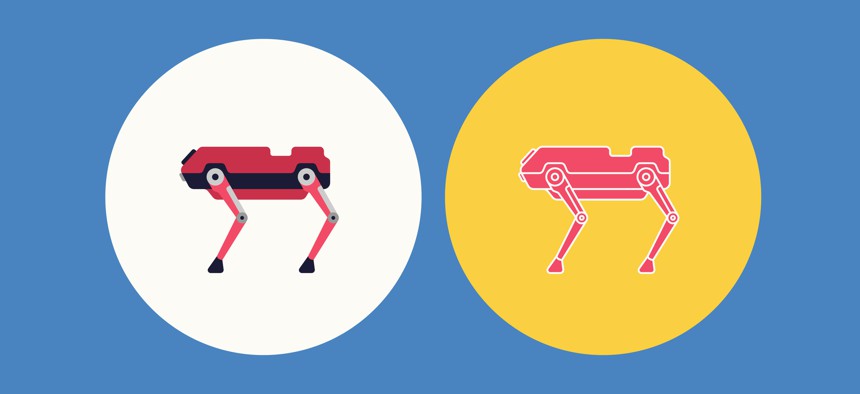Connecting state and local government leaders
Researchers have developed a robot that uses machine learning to navigate its surrounding, which scientists say could assist in search and rescue operations.
Researchers have designed a system that enables a low-cost and relatively small legged robot to get around even in the face of obstacles.
The robot can climb and descend stairs nearly its height; traverse rocky, slippery, uneven, steep, and varied terrain; walk across gaps; scale rocks and curbs; and even operate in the dark.
“Empowering small robots to climb stairs and handle a variety of environments is crucial to developing robots that will be useful in people’s homes as well as search and rescue operations,” says Deepak Pathak, an assistant professor in the Robotics Institute at Carnegie Mellon University. “This system creates a robust and adaptable robot that could perform many everyday tasks.”
Getting around without a problem
The team put the robot through its paces, testing it on uneven stairs and hillsides at public parks, challenging it to walk across steppingstones and over slippery surfaces, and asking it to climb stairs that, for its height, would be akin to a human leaping over a hurdle. The robot adapts quickly and masters challenging terrain by relying on its vision and a small onboard computer.
The researchers trained the robot with 4,000 clones of it in a simulator, where they practiced walking and climbing on challenging terrain. The simulator’s speed allowed the robot to gain six years of experience in a single day. The simulator also stored the motor skills it learned during training in a neural network that the researchers copied to the real robot. This approach did not require any hand-engineering of the robot’s movements—a departure from traditional methods.
Most robotic systems use cameras to create a map of the surrounding environment and use that map to plan movements before executing them. The process is slow and can often falter due to inherent fuzziness, inaccuracies, or misperceptions in the mapping stage that affect the subsequent planning and movements. Mapping and planning are useful in systems focused on high-level control but are not always suited for the dynamic requirements of low-level skills like walking or running over challenging terrains.
The new system bypasses the mapping and planning phases and directly routes the vision inputs to the control of the robot. What the robot sees determines how it moves. Not even the researchers specify how the legs should move. This technique allows the robot to react to oncoming terrain quickly and move through it effectively.
Because there is no mapping or planning involved and movements are trained using machine learning, the robot itself can be low-cost. The robot the team used was at least 25 times cheaper than available alternatives. The team’s algorithm has the potential to make low-cost robots much more widely available.
“This system uses vision and feedback from the body directly as input to output commands to the robot’s motors,” says Ananye Agarwal, a PhD student in machine learning. “This technique allows the system to be very robust in the real world. If it slips on stairs, it can recover. It can go into unknown environments and adapt.”
Natural inspiration
This direct vision-to-control aspect is biologically inspired. Humans and animals use vision to move. Previous research from the team had shown that blind robots—robots without cameras—can conquer challenging terrain, but adding vision and relying on that vision greatly improves the system.
The team looked to nature for other elements of the system as well. For a small robot—less than a foot tall, in this case—to scale stairs or obstacles nearly its height, it learned to adopt the movement that humans use to step over high obstacles. When a human has to lift its leg up high to scale a ledge or hurdle, it uses its hips to move its leg out to the side, called abduction and adduction, giving it more clearance. The robot system Pathak’s team designed does the same, using hip abduction to tackle obstacles that trip up some of the most advanced legged robotic systems on the market.
The movement of hind legs by four-legged animals also inspired the team. When a cat moves through obstacles, its hind legs avoid the same items as its front legs without the benefit of a nearby set of eyes. “Four-legged animals have a memory that enables their hind legs to track the front legs. Our system works in a similar fashion” Pathak says. The system’s onboard memory enables the rear legs to remember what the camera at the front saw and maneuver to avoid obstacles.
“Since there’s no map, no planning, our system remembers the terrain and how it moved the front leg and translates this to the rear leg, doing so quickly and flawlessly,” says Ashish Kumar a PhD student at the University of California, Berkeley.
The research could be a large step toward solving existing challenges facing legged robots and bringing them into people’s homes.
The researchers will present their work at the upcoming Conference on Robot Learning in Auckland, New Zealand.
Source: Carnegie Mellon University
This article was originally published in Futurity. It has been republished under the Attribution 4.0 International license.
NEXT STORY: Transit agency pilots gun detection tech



